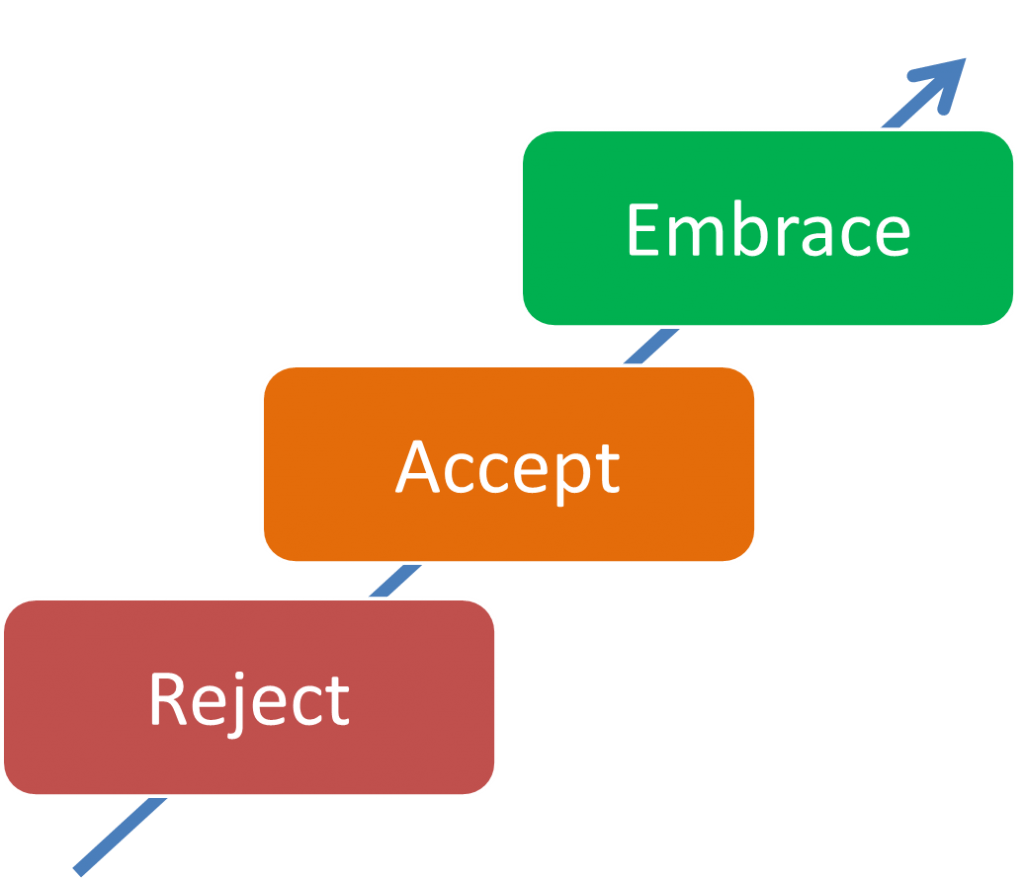The trusted advisor?
Many of us get really frustrated when business people do not immediately embrace our analytics solutions. But let’s step in their shoes for a moment. Trusting analytics for decision making is leap of faith. Imagine you are a manager who is used to listening to his gut feeling and intuition. We can’t expect that person to immediately embrace the latest and greatest analytics solution. As a matter of fact, data can often be viewed as some scary. Starting to rely on analytics can therefore often feel like the proverbial leap of faith.
Why is that so? When we simplify the feelings that a new analytics user experiences we can identify three major stages.
- Reject: Can I trust the data? What am I supposed to do with it?
- Accept: I can see the value but I can’t identify the stories
- Embrace: This is cool! What else can I do with this?
We as analytics professionals have the duty to help people make that leap of faith. We have to make it easy for them to get from stage 1 to stage 3.
A personal story
About ten years ago, I got really serious about my running and cycling. Instead of just following my gut feeling for developing a training plan, I purchased a heart rate monitor, a cycling power meter and some analytics software.
Stage 1 – Reject: The initial experience was intimidating. Getting everything to work was complicated and there were a ton of data drop-outs. What about the data itself? It did not tell me anything. All I saw was a bunch of colorful charts and nothing else. I was ready to throw the stuff out of the door. It felt like a waste of time.
Stage 2 – Accept: After a few weeks, however, things started to work smoothly and a coach finally helped me understand the charts and taught me how to identify a few weaknesses in my approach. Based on those insights, I tweaked my plan a little bit. It was a positive step forward but I was still waiting for the big impact.

Stage 3 – Embrace: Studyingbooks and consulting with other athletes allowed me to achieve a real break-through. That’s when I finally learned to really rely on the data. Here is an example: Analysis showed that I had trained too hard for over two years. I needed to change my approach and spend more time recovering. It sounded scary: Train slower to race faster? Guess what – it worked! Once I started to back off, I was able to dramatically improve my performance. And that is my personal story of moving from stage 1 (reject) to stage 3 (embrace).
Your role
Don’t expect your users to immediately embrace your cool analytics solution. It is a leap of faith. It is your job to help and coach them. Show them how they can apply their data and the associated insights. Also, make sure that you develop solutions that are easy to use and that communicate clearly. Don’t let them alone. Move them along these three stages. It’s your responsibility! You can also find some ideas how to do that on this blog.


Comments
6 responses to “Is your analytics solution a trusted advisor?”
Thanks Christoph. I think we all have challenges implmenting analytics in our organizations. I read this and I am reminded of the movie Moneyball. This movie represents the triumph of analytics over “common” knowledge.
Excellent post – one of the big challenges is that not everyone has your patience to persevere with analytics – our challenge is to make analytics intuitive then we can drive adoption and realize real value
Hey Jeff – Great to hear from you. Excellent point! It’s a great story. IBM actually hired Michael Lewis as a speaker for the Business Analytics Forum in 2011.
David – Thanks!!! Agreed – things need to be intuitive. And that means software and design need to be on par.
hi david